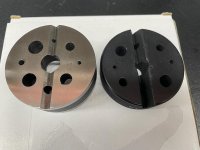I have a model 60 that has a thin/serrated trigger and I want to put a wide/smooth trigger on it. The only trigger I could find online was a "stripped" trigger which means it does not have a hand spring or the pin that holds the hand spring in.
Obviously I could take the hand spring and pin from the thin/serrated trigger and move it to the smooth trigger, but I have never done this particular thing before and I have some questions.
1. The pins on the triggers appear to be straight solid pins. I tried tapping them out gently and they don't move. So first question is ... can you tap them out with a proper hammer and punch? Or are they "pressed" in with some kind of machine at the factory making them basically permanent? In that case would I destroy them trying to remove them?
2. If I can punch them out, will they be permanently damaged? Are they single use and require a new fresh pin each time? Does anyone know what size pin that is so I can try to buy one?
3. Can I use a roll pin instead? If I can't use the one from the old trigger because I'll ruin it or it won't come out, and I can't find a new one online, then would it be acceptable to use a roll pin? All it does is hold the spring in place?
All thoughts are greatly appreciated.
Obviously I could take the hand spring and pin from the thin/serrated trigger and move it to the smooth trigger, but I have never done this particular thing before and I have some questions.
1. The pins on the triggers appear to be straight solid pins. I tried tapping them out gently and they don't move. So first question is ... can you tap them out with a proper hammer and punch? Or are they "pressed" in with some kind of machine at the factory making them basically permanent? In that case would I destroy them trying to remove them?
2. If I can punch them out, will they be permanently damaged? Are they single use and require a new fresh pin each time? Does anyone know what size pin that is so I can try to buy one?
3. Can I use a roll pin instead? If I can't use the one from the old trigger because I'll ruin it or it won't come out, and I can't find a new one online, then would it be acceptable to use a roll pin? All it does is hold the spring in place?
All thoughts are greatly appreciated.
Last edited:



